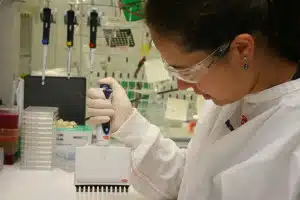Hepatitis C, which infects 10,000 Australians each year and is the country’s leading cause of liver transplantation, may have finally met its match as Melbourne scientists develop a vaccine.
Dr Patricia Vietheer and her collaborators at the Burnet Institute and biotherapy company CSL have found a way to remove the camouflage that hides the virus from the body’s immune system, developing a vaccine that could see the eventual eradication of the disease.
“Having a widely available vaccine that prevents HCV infection is essential for controlling transmission of the disease and could one day see the complete eradication of HCV,” says Patricia, who has been working on a vaccine for seven years.
“One of the challenges in HCV vaccine development is the ability of the virus to change rapidly, thereby camouflaging itself from our immune system, By removing the camouflage from the HCV virus’s surface, we discovered an underlying region that is important for the virus to attach to liver cells which we then used to design our vaccine,” she says.
HCV causes life-long liver disease and liver cancer. Globally, there are 170 million chronic carriers of the virus, with more than 200,000 infected in Australia. There is currently no available vaccine available and antiviral therapies are expensive and cause debilitating side-effects.
The vaccine is currently in the preclinical phase of development and will soon enter human clinical trials.






 Fresh Science is on hold for 2022. We will be back in 2023.
Fresh Science is on hold for 2022. We will be back in 2023.